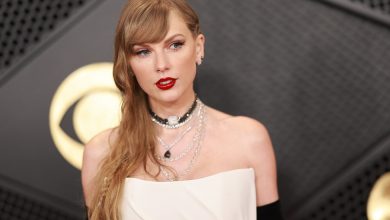The Grim Heartbeat Propelling ‘Killers of the Flower Moon’

Early in Martin Scorsese’s “Killers of the Flower Moon,” an Osage woman named Mollie gives her gravely unsuitable white suitor, Ernest, a Stetson. It’s a large off-white hat with a bound-edge brim and a wide ribbon around the band. It’s a gift but it feels more like a benediction, and anyone who’s ever watched an old western film (or “Star Wars”) will recognize the symbolism of her largess. Mollie is telling Ernest that she sees him as a good guy, even if the movie has already violently upended the familiar dualism of the white hat vs. black.
That dichotomy shapes “Killers of the Flower Moon,” a deeply American story of greed, betrayal and murder told through the anguished relationship between Mollie (Lily Gladstone) and Ernest (Leonardo DiCaprio). It’s around 1919 and Ernest is wearing his World War I uniform when he dismounts a train in Fairfax, an Oklahoma boomtown where luxury cars rumble down dirt roads. He’s come to live with his uncle, William Hale (Robert De Niro), a smooth-talking rancher who, in one breath, asks him if he has seen bloodshed and, in the next, describes the Osage as the finest and “and most beautiful people on God’s earth.”
The movie is based on David Grann’s appalling, all-too-true crime book from 2017, “Killers of the Flower Moon: The Osage Murders and the Birth of the F.B.I.” In adapting it to the screen, Scorsese and Eric Roth have dramatically narrowed the role of the F.B.I. to focus on the multiple murders — scores, perhaps hundreds — of Osage members that took place largely in the 1920s on the tribe’s oil-rich reservation in northern Oklahoma. As the 19th century gave way to the 20th, oil made the tribe among the wealthiest people in the world. It also made them the target of numerous white predators. As a 1920 article in Harper’s ominously put it: “The Osage Indians are becoming so rich that something will have to be done about it.”
The following year, Congress passed a law that required the Osage to prove they could handle their reserves “responsibly.” If they couldn’t, they were declared incompetent and appointed a guardian; it was a status, as Grann explains, that was usually given to full-blooded Osage like Mollie. It’s instructive then that the first time you see Mollie in “Killers,” she is in an office being asked to state her name by an unseen man. “I’m Mollie Kyle, incompetent,” she says, her face a serene blank. The man is her guardian, yet another smooth talker, though one with a picture of a Ku Klux Klan rider on his wall. When Mollie leaves his office, Scorsese cuts to a shot of her feet on a doormat imprinted with “KIGY,” an abbreviation for “Klansman, I greet you.”
We are having trouble retrieving the article content.
Please enable JavaScript in your browser settings.
Thank you for your patience while we verify access. If you are in Reader mode please exit and log into your Times account, or subscribe for all of The Times.
Thank you for your patience while we verify access.
Already a subscriber? Log in.
Want all of The Times? Subscribe.



